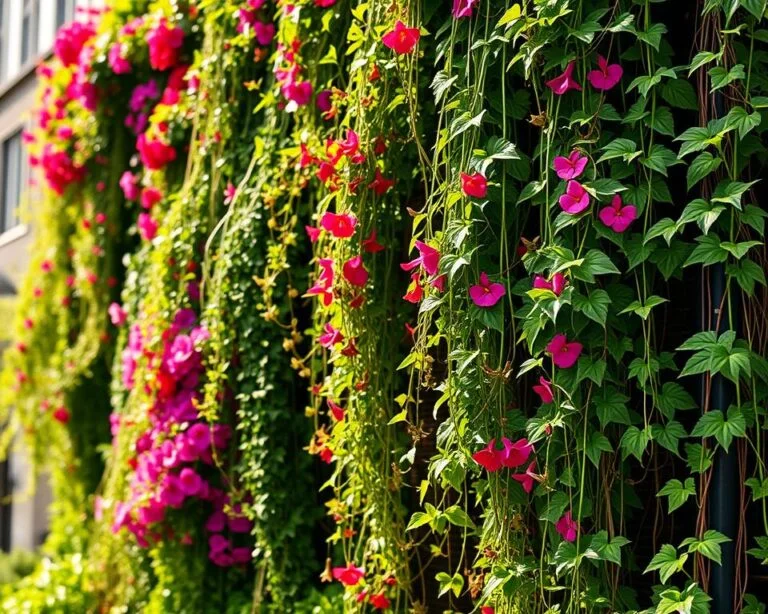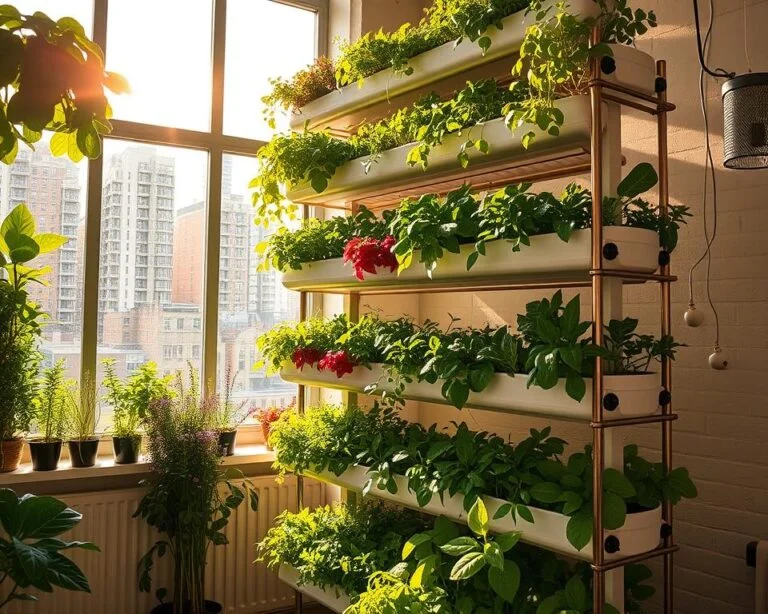Smart Urban Gardening Solutions with Containers
Ever looked out your city apartment window and wished for a lush garden? Container-gardening makes this dream come true. It’s one of the most effective urban gardening solutions for growing your own food, creating green spaces, and connecting with nature in the heart of the city.
Urban-gardening is more than a hobby; it’s a new way to live sustainably. With new container garden methods, you can turn balconies, rooftops, and windowsills into lush gardens. These gardens can grow herbs, veggies, and flowers.
Container-gardening is easy for anyone, whether you’re new to gardening or have lots of experience. You can grow everything from cherry tomatoes to fragrant herbs. It’s a green way for city folks to get fresh, homegrown food.
Key Takeaways
- Urban-gardening turns small city areas into green, productive spaces
- Container gardens give you fresh food without needing big outdoor areas
- Gardening boosts mental health and helps the environment
- Even small spaces can grow many different plants with smart gardening
- Urban gardening brings people together in the community
Getting Started with Container Gardening Basics
Urban gardening solutions have changed how city folks grow plants in small spaces. Container gardening turns balconies, windowsills, and small patios into lively green spots. It’s great for both new and seasoned gardeners to know the basics for a thriving urban garden.
Choosing the right containers is key for your vertical farming dreams. Think about these important points when picking your gardening containers:
- Container size and depth (6-8 inches for most vegetables)
- Material durability (plastic, terracotta, or ceramic)
- Drainage capabilities
- Weight and mobility
Selecting Appropriate Containers
Your container choice affects plant health. Bigger containers are more stable and need less water. Experts say containers with good drainage prevent root rot and help plants grow well.
Understanding Space Requirements
Each plant has its own space needs. Carrots need 12-18 inches of depth, while herbs do well in 6-8 inch pots. Here are some tips for planning your urban garden:
- Tomatoes and peppers need 12-14 inch deep containers
- Leafy greens do well in shallow containers
- Dwarf fruit trees can grow in large pots
Essential Tools and Supplies
Get your urban gardening kit ready with these must-haves: Quality potting mix, balanced fertilizer, hand trowel, watering can, and pruning shears. A good soil mix is 2 parts potting soil to 1 part compost. This mix gives your plants the nutrients they need.
Urban Gardening Solutions: Planning Your Small Space Garden
Turning urban areas into gardens needs creative planning. You can grow food in tiny spaces like balconies or courtyards. Urban gardeners face challenges, but smart planning can make small areas green and productive.
Here are some tips to make the most of your urban garden:
- Use vertical gardening to grow more in less space
- Build raised beds for better soil
- Try hydroponics for saving water
- Plant companions to fight pests
Community gardens are great for those without outdoor space. They offer growing areas and help neighbors connect. Studies show they can boost local plant life by 50% and support social ties.
“Small spaces can produce big harvests with the right planning and techniques.”
Water use is key in urban gardening. An edible garden can use 66% less water than a lawn. Choose plants that need little water and use smart watering methods to save water.
- Window boxes can grow herbs and small veggies
- Rooftop gardens cool cities and manage rainwater
- Container gardens fit well in small areas
Your urban garden is more than growing food. It’s about creating a green space that’s good for you and the planet.
Maximizing Limited Space with Vertical Growing Techniques
Urban gardeners face unique challenges when creating productive green spaces. Vertical growing techniques offer innovative solutions for rooftop gardens and indoor gardening. They transform small areas into vibrant, edible landscapes.

Vertical gardening lets you make the most of every square inch in your urban space. By using vertical surfaces, you can grow more plants than traditional gardens. In fact, vertical gardens can produce up to 10 times more produce per square foot than traditional gardening.
Trellises and Wall-Mounted Systems
Trellises are a great solution for gardeners with limited space. They let climbing plants grow up, saving space. Here are some options for your vertical garden:
- Wooden trellises for climbing vegetables
- Metal wall-mounted systems for herbs
- Repurposed wooden pallets as creative growing surfaces
Stackable Container Solutions
Stackable containers change urban gardening by creating multi-level spaces. These systems can support:
- 40-50 plants within 4 square feet
- Compact edibles like cherry tomatoes
- Herbs and small vegetable varieties
Space-Efficient Plant Selection
Choosing the right plants is key for vertical gardening. Look for compact climbers, dwarf vegetables, and lightweight herbs that do well in small spaces.
Pro tip: Vertical gardens can reduce water usage by up to 90% compared to traditional gardening methods.
By using these vertical growing techniques, you can turn your urban space into a productive and beautiful edible landscape.
Maintenance and Care for Container Gardens

Taking care of your urban container garden is key to its success. It’s important to know how to care for plants in containers. This is different from gardening in the ground.
Watering is a big part of container gardening. You need to watch your plants closely, more so in the summer. Here’s what experts say:
- Check the soil moisture every day
- Water until you see liquid coming out of the bottom
- Change how often you water based on how much sun they get
Composting is also crucial for your container garden. Making your own compost helps keep the soil rich. It also helps reduce waste.
“Container gardens are living ecosystems that require consistent, mindful care to flourish in urban spaces.”
Since container plants use up nutrients fast, fertilizing is important. Here are some tips:
- Choose organic, slow-release fertilizers
- Fertilize every 4-6 weeks
- Watch how your plants look to see if they need more nutrients
| Maintenance Task | Frequency | Benefits |
|---|---|---|
| Watering | Daily/As needed | Prevents plant stress |
| Pruning | Weekly | Encourages new growth |
| Fertilizing | Every 4-6 weeks | Maintains nutrient levels |
Keeping pests away from your container garden is important. Always check your plants for pests or diseases. Using natural methods like neem oil or introducing good bugs can keep your garden healthy.
Innovative Technologies for Urban Container Gardening

Urban gardening is getting a tech boost. Now, city folks can grow their own food more easily. Hydroponics and other tech make indoor gardening efficient and accessible.
Today’s urban gardeners have top-notch tools. These tools help use space well and grow plants better. New smart gadgets are changing indoor gardening, making it easier for city gardens.
- Automated irrigation systems monitor soil moisture levels in real-time
- App-controlled grow lights adjust lighting conditions automatically
- Climate control sensors maintain optimal growing environments
- IoT-enabled gardening platforms provide comprehensive plant monitoring
Hydroponics are a hit for city gardeners. They let you grow plants without soil, saving water. Vertical gardening technologies turn small areas into green spaces.
The Arduino IoT Cloud is a big deal for gardening tech. It tracks things like temperature and light with great detail. This tech helps city gardeners grow more food with less waste.
Technology is turning urban spaces into vibrant, productive gardens – one smart sensor at a time.
Conclusion
Urban gardening has changed how city folks grow food and create green spaces. With container gardening, even the tiniest spots can become productive. Urban gardens can grow up to 15 times more food than farms, making every inch count.
You don’t need big land or lots of resources to start. Container gardening is easy to begin with. It lets you grow your own food on balconies, rooftops, and more. This way, you can eat fresh, organic food and help the planet.
Urban gardens do more than feed you. They cool cities, clean the air, and home wildlife. By starting a container garden, you join a global effort for greener cities. The future of farming is local, green, and in your hands.
Even with a tiny space, you can start an urban garden. Begin small, keep learning, and watch your garden grow. It’s a way to improve your health, connect with your community, and care for the environment.







